An Opinion
Regarding
El Maestro
Andrés Segovia
In which the question is discussed whether one of the 20th Century's greatest musicians achieved his reputation for unbelievable virtuosity at least in part and perhaps inadvertently by electronic enhancement and in which the conclusion is supported by the discovery of a long-forgotten live broadcast of the great guitarist from the early years of the 20th Century.
Decades since he last appeared on stage, Andrés Segovia remains the most famous classical guitarist of all time. In fact, in the popular image, Andrés is the INVENTOR of the classical guitar.
Of course, scholars will point out that there were many guitarists playing classical music long before Andrés was born. In the early to mid-19th Century these included Ferdinando Carulli, Fernando Sor, Mauro Giuliani, Niccolò Paganini (yes, the violin Paganini), and Julian Arcas.
The Founder
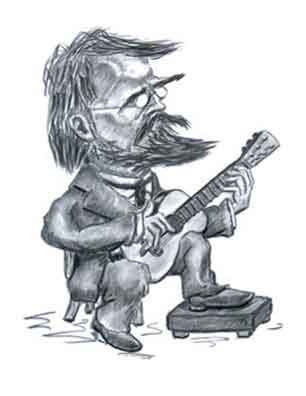
Francisco Tarrega
Y Los Contemporáneos
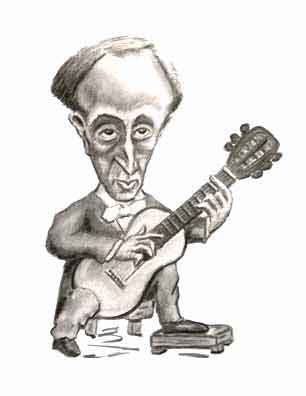
Miguel LLobet
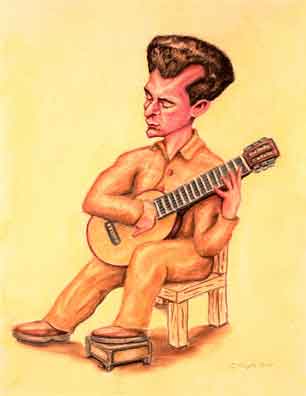
Jose Rey de la Torre
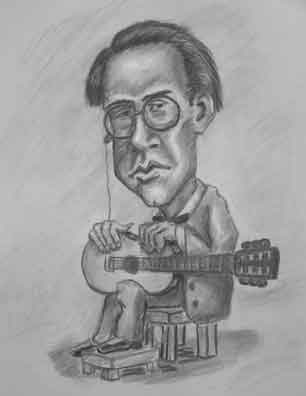
A Promising Young Guitarist
There were also guitarists who can be considered Andrés's contemporaries in the sense that they learned to play independently of his influence and their careers overlapped a good deal with his. Some of these guitarists studied with Francisco Tarrega - widely considered the founder of modern guitar technique and whom Andrés greatly admired. These included Daniel Fortea, Josefina Robledo, Emilio Pujol, and of course, Miguel Llobet. Among Miguel's own students were Luise Walker, the child prodigy María Luisa Anido, José Rey de la Torre, - and some actually think one of Miguel's students might have been a promising young guitarist named Andrés Segovia Torres!1
Footnote
As scholars have delved more deeply into the life of Andrés some have questioned whether he really was completely self-taught and suspect that he may have been something of a surreptitious student of Miguel's, even if briefly. But in Andrés's autobiography (covering his life up to his late twenties), Andrés said he met Miguel around 1915. By that time Andrés was already a performing artist and had reached the age where a professional musician's skills are more or less developed. Jose Rey De La Torre also believed contact between Segovia and Llobet was limited and that Segovia probably didn't hear Miguel perform more than a few times.
Well, then the curmudgeons ask, if there were all these other guitarists, why is it that people THINK Andrés invented the classical guitar?
Although the individual threads of Andrés's career path were by no means unique, what made him sui generis is how things were put together. Like the proverbial doctor's prescription there were a combination of ingredients in Andrés's career that enhanced his reputation to where he eclipsed everyone else.
First, no doubt about it, Andrés was good. Whether he was better than everyone else is a moot point, endlessly debatable, and not really relevant. What IS important was that when Andrés played, people listened.
Another BIG factor for Andrés's rapid rise was he was willing to spend his entire life on the road. Andrés's public debut was in 1909 in Granada when he was sixteen years old and his first professional performance was in Madrid in 1912. People were impressed, and after some wrangling about the contract (which originally required him to reimburse the agent for expenses), Andrés began touring South America to good reviews.
On his tours Andrés not only played recitals - that is, concerts in fairly small rooms before a limited audience - but full fledged concerts in large auditoria. Despite the quiet nature of the instrument2 he was soon packing them in.
Footnote
Whether classical guitars should be amplified when playing recitals and concerts has been a bit of a controversial topic. Some maintain the acoustic instrument - even those with a reputation for power - are just too quiet to be heard even in moderate size rooms. The audience has to strain to hear and by the end of the concert they can be exhausted. One famous guitarist maintained that if you sit in a large auditorium at an unamplified guitar concert all you hear is a little plink and plonk.
Andrés, though, was adamant that the guitar should NOT! NOT! NOT! be amplified EVER! Amplification, he felt, distorted the tone and if people would just keep quiet then a classical guitar could be heard even in the further reaches of a large concert hall.
Once Andrés was surreptitiously "miked" while performing in a famous auditorium and when he found out he vowed never to return again. However, another guitarist was in the audience and said the amplification was a big plus in enjoying the music.
There was at least one time that Andrés must have agreed to have amplification. That was in the 1980's when he appeared on a "theater in the round" with a rotating stage. Andrés certainly knew that without the music being sent over the sound system, most of the concert would have been audible only in bits and pieces.
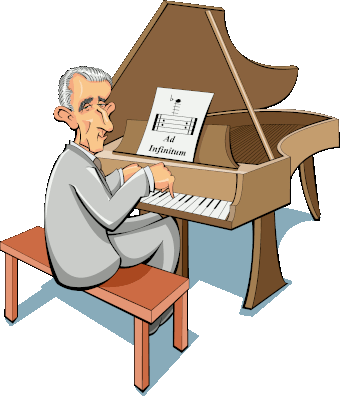
A Guy Named Maurice
Andrés's Paris debut was April 7, 1924 and was attended by some of the biggest of the bigwigs in music including a guy named Maurice. Andrés first toured the United States in 1928 where he debuted at Town Hall in New York City. Andrés was always modest about his English skills although his command of the language became quite good. Although he spoke with a Spanish accent, he was articulate and easy to understand.
By the early 1920's Andrés was so famous that newspapers would even print stories when he was just passing through town. His odysseic touring is all the more impressive since when he began his career, travel was onerous, difficult, and at times dangerous. Commercial airlines were in the future, and for long distance travel you crossed the oceans by ship and went over the land by train. But even with today's jet travel, touring can still be a grind, and yet Andrés kept performing throughout the world when he was over 90. So a lot of people saw Andrés.
And last but by no means least, Andrés began cutting records as early as 1927 and he never really stopped. Other early guitarists had made recordings, particularly Miguel Llobet, but the distribution was limited, and truth to tell the discs by Andrés are better both technically and musically. Here Andrés was fortunate in that he began recording soon after electric microphones had replaced the old acoustic horns. So even his earliest recordings are close to modern quality and Andrés garnered many fans who never saw him perform.
Andrés's first release was the "Variations on a Theme by Mozart" by Fernando Sor with Bach's "Gavotte en Rondeau" on the flip side. These were recorded in England and as we said in 1927.
The record was reviewed in The Gramophone magazine the same year. The reviewer clearly didn't know he was listening to a future legend, and he was a bit dismissive of the music and the instrument if not the performer.
Andrés Segovia (H.M.V., D.1255, 12in., 6s. 6d.3) provides us with some truly astonishing playing on the guitar, an instrument which, by the way, appears to record excellently. His rendering of a Bach Gavotte is pleasantly rhythmic and the rubato, though meretricious,4 is effective. But the result, interesting as it is, is hardly Bach, and the guitar seems more naturally suited to the pleasant, childish prattling of a Thème Varié by Sor, which is most successful. The playing is, of course, the main thing, and this no one should miss.
Footnote
A price of 6s. 6d. means six shillings and six pence. In those pre-decimalized days a pound was 20 shillings and there were 12 pence in a shilling. In 1927 the dollar value for a pound was $4.861025 (yes, the extra decimal points are correct). So to buy the record an American would have to pay $1.58.
As to what you'd have to pay today, there's various ways to calculate equivalent money values through the years. The most common "inflation calculator" is the Consumer Price Index or CPI. By the CPI, $1.58 in 1927 is $28.05.
An alternative valuation is by the Consumer Bundle. This is defined as the average dollar value of the annual expenditures of a household (or some other economic group). But because households have shrunk over time, equivalent prices based on the Consumer Bundle are larger than when calculated by the CPI. So using the Consumer Bundle $1.58 in 1927 is $58.85.
For comparison, some goods and their respective costs in 1927 are soap (25¢ for 7 bars or $1 for 100 bars), flour ($1 for 24 pounds), sugar (69¢ for 10 pounds, $6.85 per 100 pounds), honey ($1.85 per 10 pounds), canned tomatoes (45¢ for a 2½ pounds), dressed chicken (33¢ per pound), pork roast (16¢ per pound), oranges (69¢ for 3 dozen), fresh ground coffee (35¢ - 45¢ per pound), large cantaloupes (15¢ each), bananas (30¢ per dozen), eggs ($1 per 5 dozen), brown sugar (50¢ per 6 pound jar), bacon (24¢ per pound), salmon (75¢ per 2 pounds), catsup (83¢ per 5 pounds), maple syrup (35¢ per quart), and 1 roll toilet paper (7¢ for 700 sheets, 10¢ for 1000 sheets, 15¢ for 2000 sheets).
Regardless of the method of conversion calculation or the cost of food and conveniences, it's clear that in those early days, the costs of records were quite high compared to later years. By the mid-1950's a double sided 45 rpm single would typically sell for 69¢ and long play albums were selling for less than $4. When on sale the prices were even lower, and you could find long playing classical albums for as little as a dime apiece.
Footnote
This word was commonly used in the 19th century but has fallen out of favor. The meaning is actually rather negative, and in a modern dictionary we get the following definition:
mer·e·tri·cious (mer´i trish´əs), adj. 1. alluring or attractive by a show of flashy or vulgar qualities; tawdry. 2. based on pretense, deception, or insincerity. 3. of, pertaining to, or characteristic of a ...
Well, we won't belabor the point.
Andrés's virtuosity on the "Gavotte" is indeed astonishing. In fact, it's so astonishing that Andrés's friend, the composer (and chemist) John Duarte5 - felt something was up. Jack (as his friends called him) was familiar with the early recordings, and when they were re-released in 1979 on a long playing double vinyl album, he wrote the liner notes for which he won a Grammy Award.
Footnote
John pronounced his last name as the Anglicized DOO-wert. The name is, of course, of Spanish origin where it is pronounced DWAR-tay. Similar names have also had their pronunciation adapted to the local linguistics. For instance, the Heisman winning quarterback from Notre Dame, John Huarte, pronounced his name HEW-wert.
John Huarte was drafted by the New York Jets in 1965. Unfortunately (for John) the Jets also had drafted another quarterback from the University of Alabama named Joe Willie Namath. Joe became the Jets' starter and went on to superstardom where among other things he was the winning quarterback in what is one of the greatest upsets in American sports. John on the other hand and for the next nine years played for the Boston Patriots, the Philadelphia Eagles, the Kansas City Chiefs, the Chicago Bears, and the Memphis Southmen of the short lived World Football League.
Jack owned a copy of the original disc, and he found that the pitch was about a half tone too high. That is, when Andrés plays the first nearly simultaneous notes E (fourth string 2nd fret) and B (open 2nd string) which are followed by a G♯, he sounds like he's playing a D and C♯ followed by an A. Jack also found that some of Andrés's other 78's also sounded higher than concert pitch.
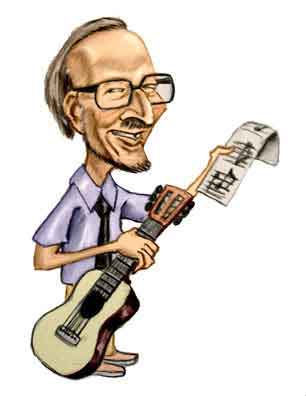
Jack Duarte
He thought something was up.

Arlo
It's not very likely.
As for what was going on, Jack offered two explanations. One was that Andrés really was exhibiting unbelievable virtuosity and that he tuned his strings a half tone up.
But as Arlo Guthrie might have put it, this wasn't very likely and we shouldn't expect it. For one thing tighter strings would make the guitar harder to play. Sure, Andrés was good, but why make his job harder than it was already?
The other explanation - and one that Jack supported by further research - was that the control of early recording equipment was inconsistent. So when Andrés cut the records, the turntable was apparently rotating at a slower speed than the standard 78.26 rpm.
Recording at a slower speed would have two effects. First it would produce a higher pitch on a 78 rpm playback. And secondly, it would make the tempo seem faster than it actually was.
So a question arises and one that is terrible to contemplate.
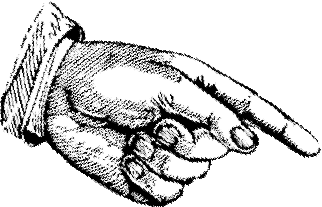 Was it possible, just possible, that Andrés's reputation for his amazing performances was aided and assisted - although perhaps unintentionally and in part - by electronic enhancement?
Was it possible, just possible, that Andrés's reputation for his amazing performances was aided and assisted - although perhaps unintentionally and in part - by electronic enhancement?
Well, nowadays with the ubiquitous (and free) audio software proliferating the ether, it's easy enough to verify that the pitch of the 1927 Gavotte is indeed higher than standard. And yes, the recording does sound like Andrés's open B-string - B3 - is playing at about 256 Hz (that is hertz, ergo, cycles per second). That's about 9 Hz too high for concert pitch and only 6 Hz from C3 (262 Hz). This is equivalent to tuning the guitar so that the tuning standard, A4, is at 457 Hz6 rather than 440 Hz.
Footnote
The reason playing a B3 at 256 Hz is too high by 9 Hz and the A5 is too high by 17 Hz is because the relationship between named musical notes and frequency is exponential, not linear. For instance the basso-profundo C2 sounds at 65 Hz and the halftone up, C2♯, is 69 Hz producing a semi-tone separation of 4 Hz. But if you move up to the soprano C6, its frequency is 1046 Hz and the C6♯ is at 1109 for a half tone separation of 63 Hz.
The difference is a bit less than a semi-tone - it's actually about ⅓ of a tone - but it does make a noticeable difference in pitch. With some rudimentary arithmetic we can conclude that during the recording the disc was spinning at about 75 rpm rather than 78.
Huh! So it seems that Andrés's reputation WAS aided by artificial enhancement, ¿verdad?
Well, no, no es necesariamente la verdad. Just un poco más research demonstrates that any "enhancement" has little effect on the virtuosity that Andrés displayed.
Over the next three decades Andrés recorded the "Gavotte" a number of times. It was clearly one of his favorites and has since become a classical guitar standard. And what you find - as Artie Johnson might have said - is veeeeerrrrryyyyyy interesting.
After the Second World War Andrés recorded the song in 1947 and 1954.7 What will strike the listener is that the style of playing - including the - quote - "meretricious" rubato - unquote - is virtually identical to the 1927 recording. Without close listening the recordings - particularly the 1947 pressing - might be mistaken for the early performance.8
Footnote
The dates of the recordings and the year that the albums were issued has been compiled by guitarist David Putnam at the Classical Guitar Forum on January 20, 2015.
Footnote
As expected the quality of the 1954 recording is better than the 1947 version. However the quality also varies with the particular album. Re-issues are not necessarily better.
But the later two recordings are at concert pitch. Or if not exactly at concert pitch they are close to concert pitch. Admittedly, the later recordings do sound a bit higher than a guitar tuned at standard A4 = 440 Hz. But we will see that whether any difference is due to slight variability in recording speeds or some other artifact of the reproduction, or if Andrés really did tune his guitar on the bright side, there would be little effect on the timing and tempo.
Now it is true that the later recordings have longer playing times than the first - but not by much. The 1927 recording runs for 2 minutes and 41 seconds9 and the 1947 recording is only a second longer - 2 minutes 42 seconds. The 1954 record is 2 minutes and 49 seconds.
Footnote
The times reported here are from when the first note - the E3 - is plucked to the start of the last chord which is the basic Emaj played on all strings. The timing from the start to finish was made by ear, and if the times are measured by the graphed musical spectrum the times come out a bit shorter.
Although the E3 and B3 are written to be sounded simultaneously, Andrés plays the E3 shortly before the B3. In fact, in his recordings Andrés often plays the intervals and chords as arpeggios - ergo, he strums the guitar. "Rolling" chords and intervals was a style popular in the Romantic era and was more common than now.
Without questioning that the 1927 recording was produced at a slower speed, if Andrés's recording in 1947 was only a second longer with the equipment working properly, then it's hard to argue that Andrés's technique needed much help. And with the recording speed in 1927 being too slow, we can conclude that Andrés was actually playing faster twenty years later!
It is tempting to wonder if the 1947 recording was a re-release of the 1927 performance but with the surface noise filtered out and the pitch adjusted. Such adjustments would have been difficult in the pre-digital days, but perhaps not impossible.
But the later recording was clearly NOT an adjustment of the first. For one thing, if the 1927 recording is slowed down to concert pitch, it would have run over 2 minutes and 50 seconds; not 2 minutes 42 seconds. Furthermore, careful listening will reveal some stylistic differences in the playing that distinguishes the earliest and later recordings.
At this point it's helpful to summarize our knowledge acquired so far.
| Gavotte Recordings by Andrés | |||
| Date of Recording | Duration | Average Metronome Marking ( | Apparent Tuning Frequency for A4 (Standard = 440 Hz) |
| 1927 | 2 min 41 sec | 80 | 457 |
| 1947 | 2 min 42 sec | 79 | 445 |
| 1954 | 2 min 49 sec | 76 | 443 |
Footnote
The time signature of the "Gavotte" is usually written in alla breve - that is, "cut time". So each measure has two half-notes and the half-note gets the beat.
The metronome markings here are timed by the number of notes played from the beginning of the playing until the start of the last chord. The repeat of the first refrain is included and the final tempo is rounded off to the nearest beat per minute.
At this point, we can sit back in satisfaction. We've heard all of the recordings of Andrés playing Bach's "Gavotte". After all, there's the 1927, 1947, and 1954 records. That's ALL the records. We haven't omitted A SINGLE RECORDING that Andrés made of Bach's "Gavotte"!
Well, hold on, there, guitarristas! There is a performance on a documentary released in 1969. There Andrés plays the "Gavotte" at a bit more languid pace - and if the ear is accurate - at a bit lower tuning.
So we can supplement our table as:
| Gavotte Recordings by Andrés | |||
| Date of Recording | Duration | Average Metronome Marking ( | Apparent Tuning Frequency for A4 (Standard = 440 Hz) |
| 1927 | 2 min 41 sec | 80 | 457 |
| 1947 | 2 min 42 sec | 79 | 445 |
| 1954 | 2 min 49 sec | 77 | 443 |
| 1969 | 3 min 4 sec | 70 | 43611 |
Footnote
Although A4 = 440 Hz is the standard most used today, there are some musicians who prefer A4 = 432 Hz. This produces, they say, a more pleasant and resonant sound. Certainly in the opinion of many, a guitar tuned a bit below A4 = 440 sounds better.
An alternative tuning is called scientific tuning. This is based on the note C where the frequency of the octaves are all whole numbers without annoying decimal fractions.
With scientific pitch, the frequencies, f, begin at C-4 - which is too low for people to hear. The formula is:
f(Hz)=2([n+4]/12)
... where n is the number of half-steps up from the ultralow C-4. So the frequencies with the increasing C octaves are:
So C-4 = 1 Hz, C-3 = 2 Hz, C-2 = 4 Hz, C-1 = 8 Hz, C0 = 16 Hz, C1 = 32 Hz, C2 = 64 Hz,, C3 = 128 Hz, C4 = 256 Hz, C5 = 512 Hz, C6 = 1024 Hz, C6 = 2048 Hz
With this tuning we can calculate that A4 is approximately 430.5389646099018460 Hz.
So NOW we have all the recordings Andrés made of the "Gavotte"! Again not a single recording omitted!
¡Pues más despacio, mis amigos! ¡Un momento, por favor!
Andrés made lots of records, and he was the subject of documentary films. But he did a lot more. If you peruse the old newspapers about Andrés's early career, you learn he also appeared on that new fangled vehicle of home entertainment called RADIO. So naturally we would expect him to have performed on what were called variety shows.
Variety shows are now pretty much moribund. But at one time they were a staple of American entertainment and were the electronic remnant of vaudeville. The show was often hosted by a well-known celebrity who introduced a number of unrelated acts one after another. Variety shows were particularly popular in the early days of television where you might have a comedian followed by a singer and the next act could be something like a magician, acrobats, or a performing dog act. The idea was to have something for everyone at a time when households only had a single set.
Guests
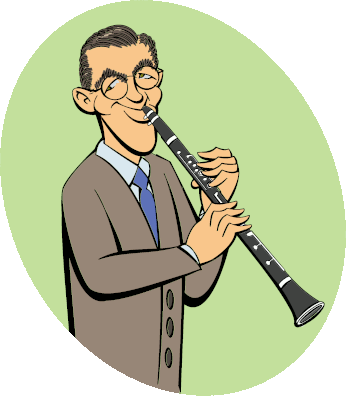
Benny
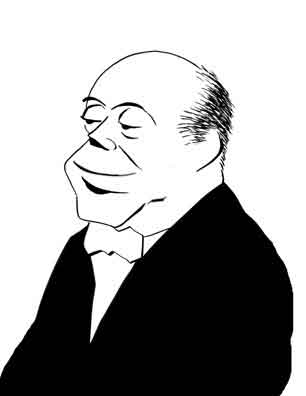
Eugene
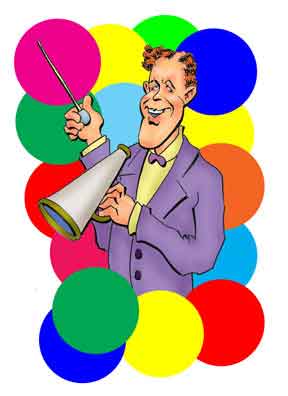
Rudy
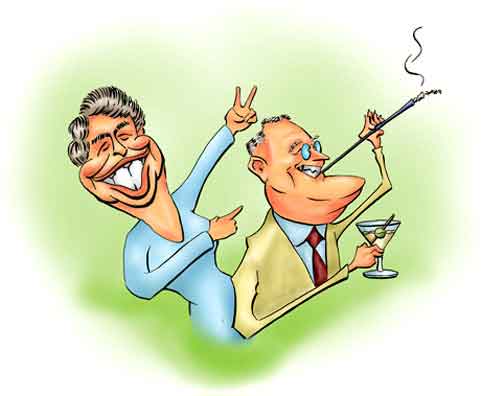
Eleanor (and Friend)
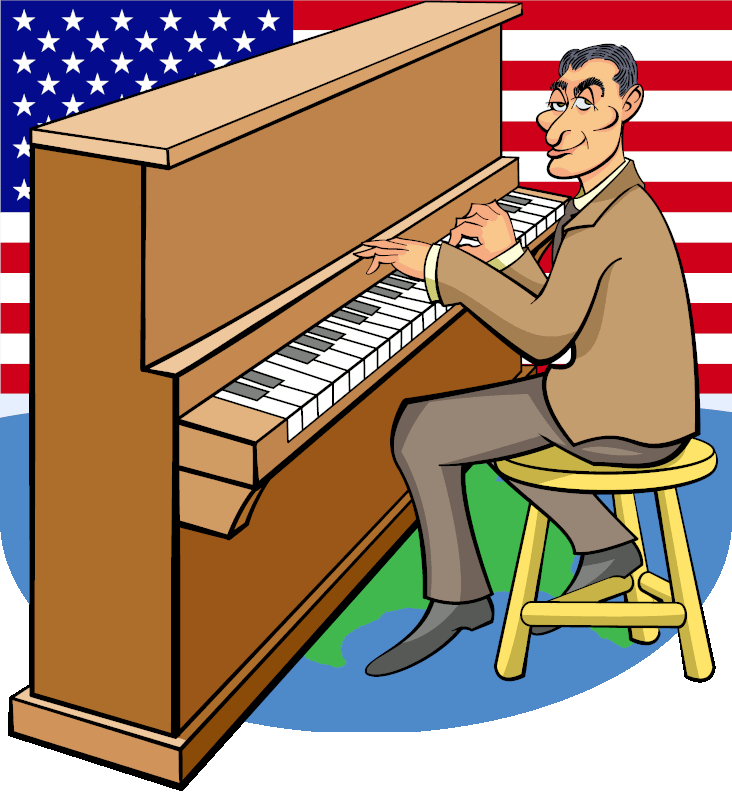
Irving
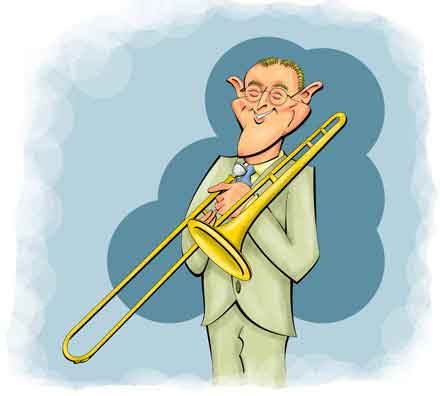
Tommy
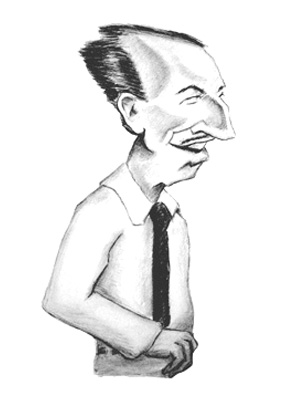
Walt
(and the Rest)
Of course, on radio the programs were limited to acts that relied on the spoken word or music, and one of these early shows that was intended to have something for everybody was The Magic Key of RCA. It was - quote - "a star studded extravaganza" - unquote. Starting on September 29, 1935, you could tune in and be entertained by the likes of Paul Robeson, Benny Goodman, The Pickens Sisters, Ruth Etting, Tyrone Power, Eugene Ormandy, Sonja Henie, Paul Whiteman and his Orchestra, the pianist and later Polish prime minister Ignace Jan Paderewski, Fred MacMurray, Metropolitan opera tenor Lauritz Melchior, the megaphone toting crooner Rudy Vallee, violinist Efrem Zimbalist (and father of actor Efrem Zimbalist, Jr.), Tommy Dorsey, First Lady Eleanor Roosevelt, Irving Berlin, Guy Lombardo, the Vienna Boys' Choir, movie mogul Darryl Zanuck, the real life married comedy duo Fibber McGee and Molly, Walt Disney, Donald Duck, Pluto, and Mickey and Minnie Mouse.
Oh, yes. And Andrés Segovia.
Yes, Andrés appeared on The Magic Key of RCA on December 29, 1935, and on the same show with George M. Cohan, Benny Goodman, and The NBC Symphony Orchestra. It was about halfway through the show that announcer Milton Cross said that Andrés was standing by at Radio Station EQA in Madrid. From there he would play the "Etude in A" by Francisco Tarrega and the "Gavotte" by Bach.
What was that last song again?
The "Gavotte" by Bach.
A recordings of the program has survived and with it Andrés's playing. So if Milton is to be believed - and who can doubt a radio announcer? - in 1935 we have a live performance of Andrés Segovia playing Bach's "Gavotte en Rondeau".
And what we find is - and we say it again - VEEEEERRRRRRRRYYYYYYY INTERESTING!!!!!.
First of all, at a first hearing Andrés's playing sounds like it's the 1927 recording. Now suspicious minds might harbor the thinking that we really are hearing the 1927 recording. You wonder if Andrés's - quote - "live performance" - unquote - is like an old radio program where the host might announce "Well, today our guest is folk singer Woody Guthrie. So we'll start off with Woody playing his famous tune, 'So Long, It's Been Good to Know You'. Step up to the mike and take it away, Woody!"
And then you hear what is clearly one of Woody's records. Then when the song is over, the announcer then says, "Thanks, Woody. That was great! And now we have a special guest star, Huddie Ledbetter, better known as 'Leadbelly' with his tune, 'Bring Me a Little Water, Sylvie.'"
Fortunately, there are good reasons to think we can rule out any such perfidy and we really are listening to a live and amazing performance.
First, the timing is faster than the 1927 record. In fact, Andrés plays the tune at a blistering
TWO MINUTES AND 27 SECONDS!!!!!
Next, if you check the tuning, Andrés IS playing at concert pitch - or at least as Isaac Newton said "pretty nearly". Again the tuning sounds a bit high - about 3 Hz above A4 = 440. But remember the 1927 recording is off by 17 Hz. Even if the 3 Hz error were from a recording produced at a non-standard speed, the song would still have a live performing time of no longer than 2 minutes and 30 seconds and not 2 minutes 41 seconds.
In other words in 1935 Andrés played the "Gavotte" fourteen seconds faster than an already rapid fire performance whose tempo was aided by sluggish recording equipment. So if you thought the 1927 recording was astonishing, hearing Andrés on the 1935 broadcast really is unbelievable.
Finally and most importantly, that neither the 1935 performance - nor any of the later ones - are modified repeats of the 1927 record is easily proven. If you mosey down to measure 72 (not counting the repeat of the first 8 bars) you find that the 1927 recording can be identified by an almost unbelievable occurrence.
There Andrés begins playing groups of two eighth notes followed by a quarter note. At the quarter note of the third group - again it is unbelievable - you will actually hear that:
ANDRÉS ACTUALLY MISSES A NOTE!!!!

Actually it isn't exactly missed. That is, Andrés doesn't actually play a wrong note. Instead it is slightly mis-fretted. Andrés may have placed a finger on the fret instead of slightly behind it or he may have not pressed down hard enough for the string to sound properly. So the note comes out as a bit of a thunk rather than the nice plink of a treble guitar string.
Today Andrés would simply do another take for just those measures and the engineers would splice it in. But in 1927 Andrés didn't have that luxury. As late as the 1950's some recording companies were still cutting records directly onto a master disc and no splicing was possible.12 If you made a glaring error you had to start all over again. So just like movie directors who sometimes let a misspoken word remain rather than reshoot an entire scene, it was best just to let Andrés's almost inaudible mistake remain.13
Footnote
Direct to disc recording had a bit of revival in the 1970's and 1980's because some artists and producers felt the sound was better if you avoided the intermediate transfer from tape to vinyl. Some classical guitarists made such records. However, the practical problems and extra expense - one mistake meant you had to throw the entire master disc out and there was some doubt that the direct recording really did sound better than taped transfers - led to the decline of the second direct-to-disc epoch.
Footnote
Although in the 1935 broadcast Andrés did not miss the note in measure 73, it does appear he made other mistakes which ironically confirm that song from the broadcast is distinct from the 1927 recording.
Bach's "Gavotte en Rondeau" as the name replies is based on the rondo. A rondo is a musical form where a constant refrain alternates with a passage called an "episode" or "statement" which varies in melody.
Bach's composition has the refrain played twice at the beginning followed by sequences where the episode variants are played and then followed by the refrain. The episode-refrain pattern is repeated a total of four times.
But a careful listening of the 1935 broadcast while reading along with the score shows that during the third episode, specifically on measures 58 and 62, Andrés garbles the passages. These are a series eighth notes and can be rather tricky to negotiate at the best of times. But on the 1927 recording these passages are played without error.
But in the 1935 broadcast?
Well, even if the sound quality isn't that great, you can definitely hear that:
ANDRÉS DOES NOT MISS THE NOTE!!!!
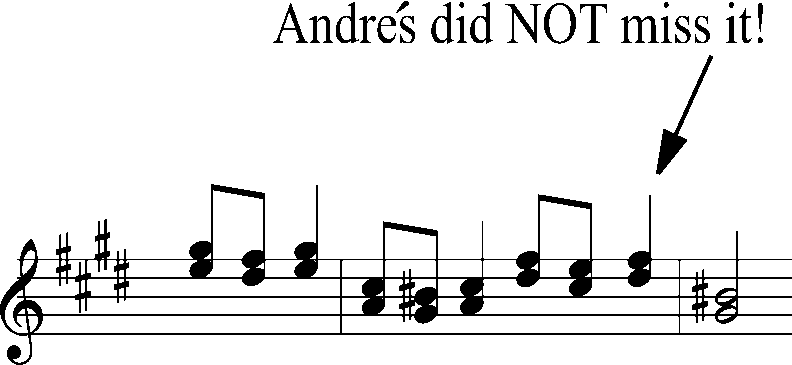
So the 1927 and 1935 recordings are NOT the same. And the playing on the 1935 recording IS faster and the virtuosity IS almost unbelievable.14
Footnote
In live concerts Andrés and other top-notch musicians are known for the occasional flub. Andrés's friend and one of the founders of Guitar Review magazine, Vladmir Bobri, once attended a concert where Andrés had trouble with a passage (and was visibly annoyed at it). This particular instance was because Andrés was trying a different left hand fingering but hadn't rehearsed it beforehand. Andrés later laughingly told Vladmir he should have known better.
So to summarize we can slip in another line into the table:
| Gavotte Recordings by Andrés | |||
| Date of Recording | Duration | Average Metronome Marking ( | Apparent Tuning Frequency for A4 (Standard = 440 Hz) |
| 1927 | 2 min 41 sec | 80 | 457 |
| 1935 | 2 min 27 sec | 88 | 443 |
| 1947 | 2 min 42 sec | 79 | 445 |
| 1954 | 2 min 49 sec | 76 | 443 |
| 1969 | 3 min 4 sec | 70 | 436 |
So what, as Flakey Foont asked Mr. Natural, does it all mean?
Well, it definitely means more than Mr. Natural's famous reply. Instead based on the totality of the evidence we now know:
In 1935 Andrés Segovia performed on the NBC radio program The Magic Key in a remote broadcast from Madrid.
Andrés played the "Gavotte en Rondeau" (BMV 1006) in the same style as his 1927 recording.
The tuning was near concert pitch and the actual performing time was 4 minutes and 27 seconds. This is significantly faster than the 1927 recording whose playback tempo was increased due to a slower recording speed. It's also half a minute faster than many top-notch professional guitarists play it today.
And in conclusion (to quote Shakespeare), we know that:
 Electronic
Electronic
Enhancement?
Andrés didn't need electronic enhancement!
But sometimes he did need a little help. If not in playing the guitar, then in other matters - like negotiating US Customs.
A newspaper story reported that when Andrés arrived in New York for his first American tour, he had two guitars. At that time classical guitars were such an oddity in the United States that the customs agents didn't know how nto classify them. So Andrés declared them in a way that was comprehensible to the inhabitants of Los Estados Unidos.
"Two banjos," Andrés said. "Two big banjos."
References and Further Reading
Segovia: An Autobiography of the Years 1893-1920, Marion Boyars Publishers Ltd, 1977.
Segovia: A Celebration of the Man and His Music, Graham Wade, Allison and Busby, 1983.
Andrés Segovia: As I Knew Him, John Duarte, Mel Bey Publications, 1998.
"Segovia: A Centenary Celebration", Parts 1 - 17, Graham Wade, Classical Guitar, February, 1993 - June, 1994.
"Andres Segovia: Studio Recordings and Discography", David Putnam, Classical Guitar Forum, January 20, 2015.
"Andrés Segovia: Studio Recordings and Discography", Segovia Guitar.
A Little Nightmusic: Intimate Conversations with Jascha Heifetz, Vladimir Horowitz, Gian Carlo Menotti, Leontyne Price, Richard Rodgers, Artur Rubinstein, Andres Segovia, Samuel Chotzinoff, Harper & Row, 1964.
"The History of the Modern Classical Guitar and its Deep Iberian Roots", Mark Small, Classical Guitar.
"The Essential Andrés Segovia", Scott Cmiel, Classical Voice of San Francisco, July 18, 2023.
"Legendary Classical Guitarist Andrés Segovia Plays Timeless Pieces by J.S. Bach", Open Culture, February 17th, 2016.
"Andres Segovia", Augustine Strings.
"Analytical Notes and First Reviews: Guitar, Andres Segovia", The Gramophone, August 1927, p. 102.
"El Gran Guitarerista Andres Segovia Ventra a Puerto Rico", El Mundo [San Juan, Puerto Rico], March 3, 1923, Page 3, Chronicling America, Library of Congress.
"Artist on Romantic Instrument", The [Washington, D. C.], Sunday Star, Part 3, October 16, 1927, p. 5 (p. 77), Chronicling America, Library of Congress.
"The Return of the Razz-Ma-Tazz", The [Washington, D. C.], Doris Kanter, Sunday Star Magazine, April 1, 1956, p. 9 (p. 123), Chronicling America, Library of Congress.
"On This Day: Andres Segovia Starts Last U.S. Tour", United Press International, January 4, 2018.
"Andrés Segovia: Still on the Road", Colin Cooper, Classical Guitar, January/February, 1983.
"30 Years On: Perspectives On the Legacy of Andrés Segovia", Graham Wade Classical Guitar, 2017.
"The History of 78 RPM Recordings", Irving S. Gilmore Library, Yale University.
Random House Compact Unabridged Dictionary, Random House, 1996.
"Andres Segovia Discography", Discogs
"Andrés Segovia at Los Olivos", Andrés Segovia (performer), Christopher Nupen (producer and director), Allegro Films, Argos Productions, Ltd., 1969.
The Very Best of Andres Segovia, Guitar Genius, Everest Records.
"Bach, Johann Sebastian: 3 Sonaten und 3 Partiten; vl , 1727-1734 (ca.)", Bach Digital, Staatsbibliothek zu Berlin – Preußischer Kulturbesitz.
"I Grandi Interpreti: Andres Segovia", Andrés Segovia (performer), Kirk Browing (director), David Suskind (producer), James Fleming (Producer), Screen Gems, Talent Associates Paramount, Ltd., Rai Italia, 1956.
"Andres Segovia a Fondo", Andrés Segovia (performer), Kirk Browing (director), David Suskind (producer), James Fleming (Producer), Screen Gems, Talent Associates Paramount, Ltd., Rai Italia, 1976.
"Gavotte en Rondeau", Andrés Segovia, Parlophone Records, 1927.
Segovia, Andres Segovia (performer), Patricia Foy (producer), BBC TV, 1961.
Segovia - Bach Chaconne And Other Works By Sor, Mendelssohn, Villa-Lobos, Rodrigo, Decca, 1955 (Reissue: 1969).
The Art of Segovia, Deutsche Gramophone, 1954.
A Bach Recital, Everest, 1965.
The Golden Years of Andres Segovia: 1952 - 1954, Instituto Discografico Italiano.
John Williams: The Four Lute Suites, Columbia, 1975.
The Magic Key of RCA, NBC, December 29, 1935.
"Andrés Segovia", Radio Swiss Classic.
"The Magic Key of RCA", Old Time Radio Catalog.
Measuring Worth, 2024.
"Foreign Exchange Rates, 1922-1928", Federal Reserve Bulletin, January 1929.
"R. & B. Sontheimer, Inc.", The Lexington [Kentucky] Avertiser, February 24, 1927, p. 8, Chronicling America, Library of Congress.
"Richolt's Cash and Carry", The Bismarck [North Dakota] Tribune, August 26, 1927, Page 2, Chronicling America, Library of Congress.
"Brown and Tiedman", The Bismarck [North Dakota] Tribune, September 16, 1927, Page 2, Chronicling America, Library of Congress.
"Cook's Grocery", The Bismarck [North Dakota] Tribune, September 16, 1927, Page 2, Chronicling America, Library of Congress.
"Nicola's Service Grocery", The Bismarck [North Dakota] Tribune, May 20, 1927, Page 4, Chronicling America, Library of Congress.
"Southside Grocery", The Bismarck [North Dakota] Tribune, September 9, 1927, Page 2, Chronicling America, Library of Congress.
"Southside Grocery", The Bismarck [North Dakota] Tribune, August 19, 1927, Page 2, Chronicling America, Library of Congress.
"Leadership in Values", The [Washington, D. C.] Evening Star, July 25, 1927, p. 3, Chronicling America, Library of Congress.
"Music Sales Corp.", The [Washington, D. C.] Evening Star, February 2, 1955, p. 20, Chronicling America, Library of Congress.
"Lansburgh's Friday Bargains", The [Washington, D. C.] Evening Star, March 24, 1955, p. B-8, Chronicling America, Library of Congress.
"9 of the World's Greatest Musical Treasures", The [Washington, D. C.] Sunday Star, February 6, 1955, p. 147, Chronicling America, Library of Congress.